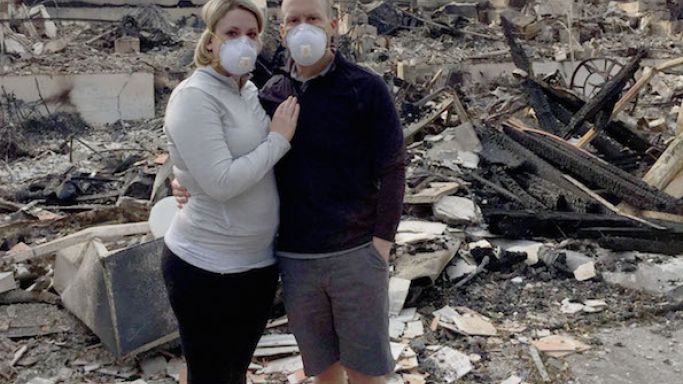You can help the poor people described below, and sample more than 40 fine California wines, by buying a ticket for our fundraising wine tasting on 2 December in London. See how here, and see Taste bright lights from California for a list of the wines.
On 8 October, Nick Solga and his girlfriend Katie Bower (pictured above with what remains of their house) were relaxing at home and getting ready to go to bed after a long day touring wine country with Katie’s parents, who were visiting from out of town. Their little French bulldog circled restlessly in their bedroom on the third floor of their townhome in Santa Rosa, California, as winds howled across their balcony outside.
Solga, who offers social media and marketing services to various wineries, recalled smelling smoke. ‘I asked Katie if she had blown out a candle or something, but she hadn’t, so we went out on the balcony and smelled smoke on the wind. We looked around to see if we could see any fire, but we couldn’t.’
The couple were nervous enough that they didn’t go to sleep. Instead they went out onto their street where many of their neighbours were doing similar investigations and gossiping quietly on the street at midnight.
‘There were college kids sitting on the back of cars and we asked them if they had seen anything, and they said they hadn’t but I remember them saying how eerie it felt, and I remember they were exactly right. It was just eerie. One of my older neighbours said he had never seen winds this strong in all his years living there', said Solga.
Katie was worried enough that she called the Santa Rosa Fire Department. She was asked if she could see an active fire. She said no, and was admonished not to call the fire department unless there was an active fire.
‘We didn’t go back to bed', said Solga. ‘It was 12.20 in the morning and we kept looking out the window, and I got onto social media and started poking around. I remember seeing a photo of a fire on Facebook, and finding the first alerts about residents of Santa Rosa near Mark West Springs Road needing to prepare to take cover. But it was quiet in our neighbourhood. We got no alerts, and no calls.’
And then at 12.55 Katie called to Nick from downstairs. '"The moon is red", she said, and I came downstairs to stand with her and watched it go from deep red to being completely obscured by smoke. Then I looked down and saw that there was ash accumulating on the back patio.’
‘We went back out front', continued Solga, ‘and saw the orange glow over the hills behind where Paradise Ridge Winery was, and that’s when Katie decided we needed to get out.’
At 1.20 am Solga and Bower roused her parents, grabbed the dog, their passports, a few items of clothing, and jumped in their car to drive south.
It was around this time that Lisa Mattson, director of marketing for Jordan Winery, got an alert on her mobile phone stating that the Riebli Road neighbourhood a few miles from her house was under mandatory evacuation. For her, it was 10.30 am as she was just about to begin a tour of Segura Viudas winery in the Penedès region of Spain, where she was spending a week with friends following a trip to celebrate her twelfth wedding anniversary.
‘My husband called our house sitter, who was home with Dante, our Italian greyhound', said Mattson. ‘Luckily, her dad had already called her and woken her up. She was on the road already. She rushed out with the dog, his leash and her purse. That's about it.’
In the hours that followed, Mattson found it difficult to concentrate on the wine tour. ‘I started texting my neighbours to make sure they were out, and then my friends and co-workers who live in Fountaingrove, my neighbourhood. My phone kept blowing up with mandatory evacuations. Sky Farm. Mark West Springs. Ursuline Road. Coffey Park. I had this sinking feeling in my chest. I felt so helpless. There was nothing we could do so far away – so detached but so connected to the horror, not able to see what was happening in the darkness of the night.’
‘There was no cell service in the small town we went to for lunch', recalled Mattson. ‘I’m not sure if that was good or bad, but it provided a break while my mind ran wild. I stayed glued to my iPhone for the next three or four hours, blowing my international data plan, trying to find out what was happening.’
By the time evening rolled around in Sitges, Spain, the onslaught of TV news coverage of the Tubbs Fire had begun, and a neighbour snapped a photo of her TV screen showing helicopter footage of Mattson’s neighbourhood.
‘All of the houses were just glowing embers in rubble. But I looked closely, and my house still had a roof', says Mattson. ‘I looked closer, and Scott Eason's white Porsche was still visible in the driveway. Our garage roof was also intact. The house was still standing. Another neighbour's house seemed to still be standing too, but we were the only ones in the photo. That’s when the strange combination of relief and panic set in.’
After figuring out that the only people allowed into active fire areas were first responders and journalists, Mattson eventually connected with a KGO reporter through social media and convinced them to go take a look at her home. Somewhat miraculously, the reporter obliged, but the video that reporter broadcast on the evening news showed smoke pouring out of Mattson’s garage door.
Mattson, and as many friends as she could enlist over the internet, made a desperate attempt to let emergency personnel know that there was a house that might be saved.
‘They told us they were not saving structures, they were still saving lives, and that they would put us on their “very long” list', said Mattson, ‘and then I broke down and cried. It was not okay that our house made it through the fire, and now – like eight hours after the firestorm passed – it may go down in flames? To lose all of it because we were away and there was no one to grab a garden hose to keep the boxes in our garage from catching on fire the following morning and burning everything down ... that really hurt.’
Solga and his entourage, meanwhile, had booked a room in Rohnert Park, 10 minutes’ drive south, only to be woken up an hour or two later by text alerts telling them that parts of Rohnert Park were now being evacuated. Operating on very little sleep, the family retreated to a Holiday Inn near San Francisco airport where Bower’s parents were due to depart the next day, and tried to get some rest. Before taking Bower’s parents to the airport the next day, they received a video from a neighbour showing what remained of their home.
‘The only thing we recognised was the charred remains of a little gazebo that used to sit next to our house', said Solga. ‘There was just orange sky, haze, smoke, and everything – everything – was ash.’ Their three-storey townhouse was gone.
The next glimpse that Mattson got of her house did little to mitigate her anxiety. Taken by the wife of a local firefighter, a photo sent by a friend showed her garage in flames, but also hoses from a fire truck snaking around and into her home. She finished her vacation knowing that her home still stood, but with the extent of the damage still very much uncertain.
It took nearly two weeks before Mattson was allowed to return to her neighbourhood, and only yesterday, 13 November, did she receive a true assessment of the extensive damage.
‘We are looking at a minimum of 12 months before we can be back in the house due to the damage', Mattson wrote in an email. ‘We were thinking it would be like six months; we only signed a six-month lease.’
Solga and Bower are staying with friends as they try to find a place to rent in a market where demand outstripped supply by as much as 10%. ‘Legally people are only allowed to raise rents 10%, but prices have gone up 15% in the last four weeks', said Solga.
* * *
These are but two of the thousands of similar stories from the worst fires in the history of California. With more than 8,000 structures destroyed, and insurance claims already exceeding $3.3 billion, the recovery will take years. This despite the tireless efforts of charities, and the significant outpouring of support the region has received.
‘We still have a huge need', said Susan Shaw, one of the organisers of Undocufund, a charity set up to assist undocumented immigrants affected by the fires that has collected only $1.4 million of its $5 million target. Undocumented immigrants are ineligible for federal aid, and cannot get low-interest loans or grants to assist with housing.
‘There are an estimated 28,000 undocumented folks in Sonoma County, and we think at least 1,200 of them have been affected by the fires', said Shaw, ‘But it is extremely difficult to determine. Undocumented folks don’t go to shelters, they’re frightened.’
In Mendocino, where the Redwood Complex Fire destroyed more than 300 homes and property damages are estimated at more than $100 million, the Community Foundation of Mendocino has been raising funds as fast as they can. ‘According to unofficial FEMA numbers, I think we were only about 67% insured so there is a definite shortfall locally', said CEO Megan Barber Allende. ‘Very few of the renters were insured at all so there will definitely be hardship among those folks if and when they land in their next homes. At the moment we have no rentals available [in the county].’ The foundation raised $1 million in the weeks following the fires, and hopes to reach $2 million, with the help of additional corporate donations.
‘The generosity we've seen has been incredible', said Elizabeth Brown, President and CEO of the Sonoma Community Foundation, ‘individuals, businesses, and foundations from across the country have reached out to support our Sonoma County Resilience Fund and have donated close to $7 million to date.’
While donations have slowed, they continue to stream in, which Brown said is unusual following similar events. ‘I think people have a sense of the extreme impact. Whatever the reason, we are so grateful that we are bucking the trend of the 10-day disaster giving window.’
The Napa Community Foundation has also raised $7 million for fire relief to date. ‘The pace has been frenetic', said CEO Terence Mulligan. ‘Things are slowing up a bit, as you'd expect them to with the fires 100% contained and other things in the news. Still, we think there is another $1–2 million likely coming in from several large charitable events in the weeks ahead. I think we may need another $5 to $6 million to help all those who will ultimately require assistance, particularly as we think about housing people in a housing market that was already, before the fire, incredibly expensive and very tight in terms of vacancy rates.’
In every area affected by the fires, more aid will undoubtedly be needed, as families like Solga’s and Mattson’s (and many more thousands less fortunate) reckon with the cascading effects of loss of home, loss of possessions and, in many cases, loss of work.
When asked to predict the time required for a recovery, few people I spoke with offered timelines of less than five years. There’s a lot of work ahead.
If you find yourself in a position to give, California Wine Country could sure use your help.
Find out more about how you can help here.

